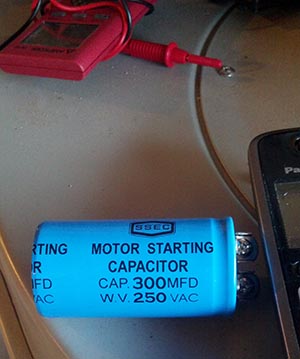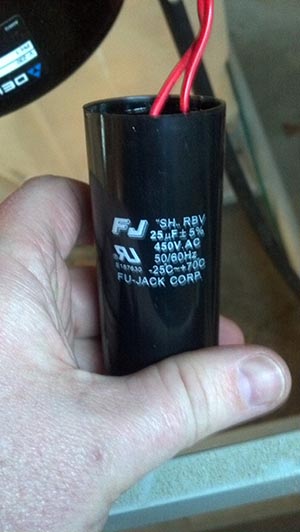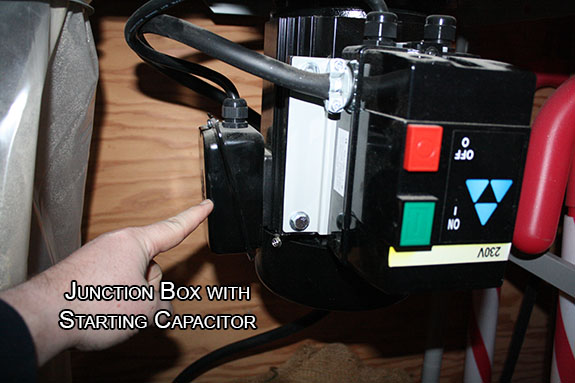How To Replace Start Capacitor On Dust Collector Motor
Defective Motor Start Capacitor Prevents Motor from Starting
 Recently my dust collector quit working and it was quickly apparent how instrumental the dust collector is in the woodshop. After getting over the shock of the breakdown I started trouble-shooting the problem. It didn’t take long to have several different people tell me it sounded like a bad Motor Start Capacitor. I sure liked the sound of that considering a 3HP motor can cost $500 to $1,000!
Recently my dust collector quit working and it was quickly apparent how instrumental the dust collector is in the woodshop. After getting over the shock of the breakdown I started trouble-shooting the problem. It didn’t take long to have several different people tell me it sounded like a bad Motor Start Capacitor. I sure liked the sound of that considering a 3HP motor can cost $500 to $1,000!
The Symptoms
In my woodshop I use a Delta 50-763 dust collector which uses a single phase, 220 V, 3 HP motor. The symptoms for this problem were very straight forward. When I turned on the power to the dust collector the motor made a very loud humming noise but it was clearly not rotating up to speed. That was easy to hear because the dust collector spins so fast typically that it sounds like a very loud rush of air from a monster vacuum.
The Diagnosis
After describing the problem to several people including Pat from ToolBoxBuzz.com, and my buddy Rob over at AConcordCarpenter.com, I decided that it was likely a capacitor issue. In order to be sure of my diagnosis I called the Technical Support people at Delta. Within just a few minutes of describing what had happened the man (a guy physically sitting in an office here in the U.S.!!!) said it was almost certainly a Start Capacitor. Gotta love confirmation from the experts!
The Fix
WARNING: If you’re not comfortable working on electric circuits please consult a qualified electrician. Electrical shock can be very dangerous and even life threatening.
According to the parts diagram from Delta this motor uses both a Starting Capacitor and a Run Capacitor. Unfortunately the diagram shows both capacitors being located under the same exterior cylindrical metal housing bolted to the side of the motor. When I removed the housing I only found one capacitor (pictured at right).
Looking at the new starting capacitor compared to the one pictured at right, I quickly realized these were not the same. In fact, if you look at the capacitance of each of them you can easily see the difference. The black one (located under the housing on the side of the motor only lists a capacitance of 25 micro farads. Yet, the other capacitor clearly shows a capacitance of 300 micro-farads. Obviously the black capacitor is the smaller “run” capacitor and not the starting capacitor I was looking for.
These capacitors are the size of a “D” battery so it’s not like they can be hidden in many places. The motor itself has three things bolted to the side: the first is the motor starter and on/off switch, second is the cylindrical housing that I just mentioned, lastly there is a small junction box where the power from the motor starter joins with the power cables to the actual motor. I decided to open it and guess what I found? That’s right, I found the blue “starting capacitor”.
What’s not shown in the picture above is the other cylindrical housing that has the run capacitor in it.
Be very careful when handling capacitors. By their very nature they hold a charge and can quite easily give you a nasty shock. So be sure you de-energize it before removing it. To replace the old capacitor with the new you should turn off the power. Next locate the start capacitor and de-energize it. Simply remove the old capacitor and install the new one using the two screws. Put all the wires back into the housing and close it up.
The Motor Runs Again
After making the repairs the dust collector works just like new. Apparently this is a fairly common problem with larger capacity motors. The fix only took about 5 minutes and the help from Delta’s customer service department was top notch. If you own a dust collector (or frankly other pieces of equipment with large electrical motors) and it makes a humming noise when you turn it on, without working, it could be a motor starting capacitor. Replacing a capacitor is easy to do and not very time consuming.














I had one go out on a HVAC fan about 2 weeks ago (run capacitor). In that case though, I pulled the fan motor as well. If they sit there “humming” for long, they tend to overheat and that can shorten the lifespan. It may have continued to work, but while I had it pulled out of the unit I was going to replace it.
I’d have taken some pictures, but I was crawling around in a dirt crawl space. It wasn’t the best situation for a camera.